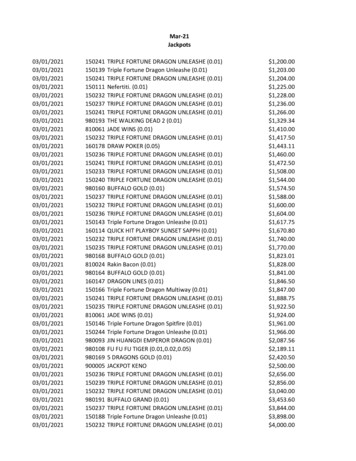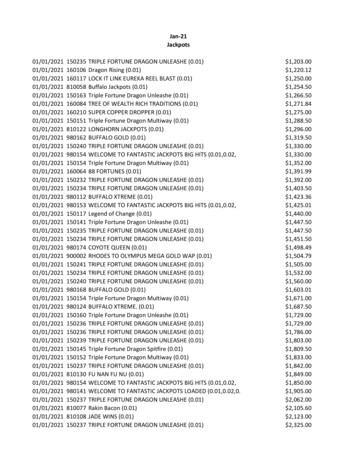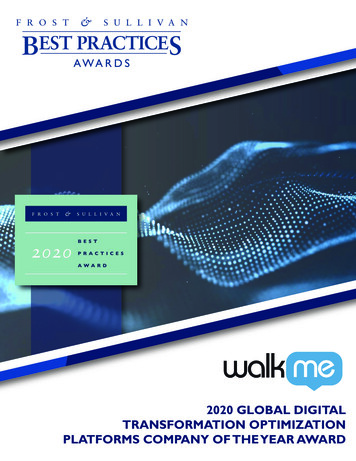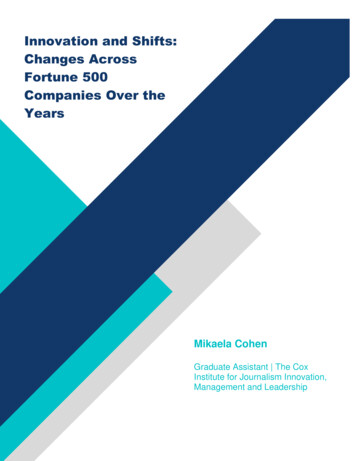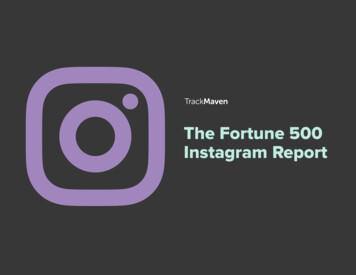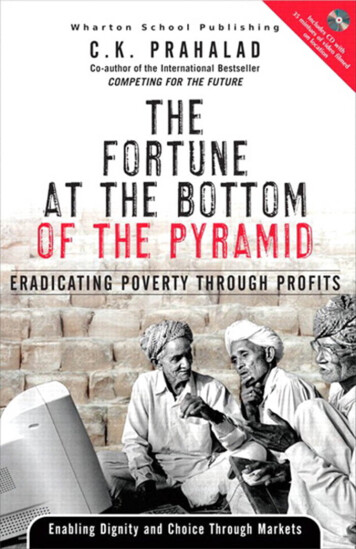
Transcription
Praise forThe Fortune at the Bottom of the Pyramid“C. K. Prahalad argues that companies must revolutionize how they do businessin developing countries if both sides of that economic equation are to prosper.Drawing on a wealth of case studies, his compelling new book offers an intriguingblueprint for how to fight poverty with profitability.”Bill GatesChairman and Chief Software Architect,Microsoft“The Bottom of the Pyramid belongs at the top of the reading list for businesspeople, academics, and experts pursuing the elusive goal of sustainable growth inthe developing world. C. K. Prahalad writes with uncommon insight aboutconsumer needs in poor societies and opportunities for the private sector to serveimportant public purposes while enhancing its own bottom line. If you arelooking for fresh thinking about emerging markets, your search is ended. This isthe book for you.”Madeleine K. AlbrightFormer U.S. Secretary of State“Prahalad challenges readers to re-evaluate their pre-conceived notions about thecommercial opportunities in serving the relatively poor nations of the world. TheBottom of the Pyramid highlights the way to commercial success and societalimprovement—but only if the developed world reconceives the way it deliversproducts and services to the developing world.”Christopher RodriguesCEO, Visa International“An important and insightful work showing persuasively how the private sectorcan be put at the center of development, not just as a rhetorical flourish but as areal engine of jobs and services for the poor.”Mark Malloch BrownAdministratorUnited Nations Development Programme“Most people recognize that poverty is a major problem in the world, yet theythrow up their hands and say, ‘What to do?’ Not so C. K. Prahalad. TheFortune at the Bottom of the Pyramid gives us hope and strategies foreradicating poverty through profits that benefit all. Pass this book on to those whoneed to read it.”Ken Blanchardco-author of The One Minute Manager andThe Secret: What Great Leaders Know-And Do
In the face of accelerating turbulence and change, business leaders and policymakers need new ways of thinking to sustain performance and growth.Wharton School Publishing offers a trusted source for stimulating ideas fromthought leaders who provide new mental models to address changes instrategy, management and finance. We seek out authors from diversedisciplines with a profound understanding of change and its implications. Weoffer books and tools that help executives respond to the challenge of change.Every book and management tool we publish meets quality standards set byThe Wharton School of the University of Pennsylvania. Each title is reviewed bythe Wharton School Publishing Editorial Board before being given Wharton’sseal of approval. This ensures that Wharton publications are timely, relevant,important, conceptually sound or empirically based, and implementable.To fit our readers’ learning preferences, Wharton publications are available inmultiple formats, including books, audio, and electronic.To find out more about our books and management tools, visit us atwhartonsp.com and Wharton’s executive education site,exceed.wharton.upenn.edu.
The Fortune at theBottom of the PyramidC. K. PrahaladHarvey C. Fruehauf Professor ofCorporate Strategy and International BusinessThe University of Michigan Business School
A CIP record of this book can be obtained from the Library of CongressEditorial/Production Supervision: Patti GuerrieriArt Director: Gail Cocker-BoguszManufacturing Manager: Alexis R. Heydt-LongManufacturing Buyer: Maura ZaldivarExecutive Editor: Tim MooreEditorial Assistant: Richard WinklerDevelopment Editor: Russ HallMarketing Manager: Martin LitkowskiCover Design Director: Jerry VottaCover Design: Chuti PrasertsithCover Photograph: Oriol Alamany, CorbisInterior Design and Composition: Meg Van Arsdale 2005 Pearson Education, Inc.Publishing as Wharton School PublishingUpper Saddle River, NJ 07458Wharton School Publishing offers excellent discounts on this book when ordered in quantityfor bulk purchases or special sales. For more information, please contact:U.S. Corporate and Government Sales, 1-800-382-3419, corpsales@pearsontechgroup.com. Forsales outside of the U.S., please contact: International Sales, Company and product names mentioned herein are the trademarksor registered trademarks of their respective owners.All rights reserved. No part of this book may be reproduced, in any form or by any means,without permission in writing from the publisher.Printed in the United States of AmericaFirst PrintingISBN 0-13-146750-6Pearson Education Ltd.Pearson Education Australia Pty., LimitedPearson Education South Asia Pte. Ltd.Pearson Education Asia Ltd.Pearson Education Canada, Ltd.Pearson Educación de Mexico, S.A. de C.V.Pearson Education—JapanPearson Malaysia SDN BHD
WHARTON SCHOOL PUBLISHINGC. K. PrahaladTHE FORTUNE AT THE BOTTOM OF THE PYRAMIDEradicating Poverty Through ProfitsYoram (Jerry)Wind, Colin Crook, with Robert GuntherTHE POWER OF IMPOSSIBLE THINKINGTransform the Business of Your Life and the Life of Your BusinessScott A. ShaneFINDING FERTILE GROUNDIdentifying Extraordinary Opportunities for New Ventures
WHARTON SCHOOL PUBLISHINGEditorial BoardThe Editorial Board of Wharton School Publishing is comprised of the following members from the seniorfaculty of the Wharton School. The Editorial Board ensures all manuscripts and materials meetWharton’s standard by addressing important topics with ideas and insights that are Relevant Empirically based Timely Conceptually sound Implementable in real decision settings Dr. David C. SchmittleinIra A. Lipman ProfessorProfessor of MarketingDeputy Dean, The Wharton SchoolChair of the Editorial Board Dr. Yoram (Jerry) WindThe Lauder Professor, Professor of MarketingDirector, The Wharton FellowsDirector, SEI Center for Advanced Studies inManagementWharton Editor, Wharton School Publishing Dr. Franklin AllenNippon Life Professor of FinanceProfessor of EconomicsCo-Director, Financial Institutions Center Dr. Peter CappelliGeorge W. Taylor Professor of ManagementDirector, Center for Human Resources Dr. Thomas DonaldsonMark O. Winkelman Professor Dr. Richard J. HerringJacob Safra Professor of International BankingProfessor of FinanceCo-Director, Financial Institutions Center Dr. John C. HersheyDaniel H. Silberberg ProfessorProfessor of Operations and InformationManagementDr. Paul R. KleindorferAnheuser-Busch Professor of ManagementScienceProfessor of Decision Sciences, Economics,and Business and Public PolicyCo-Director, Risk Management and DecisionProcesses Center Dr. Ian C. MacMillanFred R. Sullivan ProfessorProfessor of ManagementDirector, Sol C. Snider EntrepreneurialResearch Center Dr. Andrew MetrickAssociate Professor of Finance Dr. Olivia S. MitchellInternational Foundation of Employee BenefitPlans ProfessorProfessor of Insurance and Risk Managementand Business and Public PolicyExecutive Director, Pension Research CouncilDirector, Boettner Center for Pensions andRetirement Research Dr. David J. ReibsteinWilliam Stewart Woodside ProfessorProfessor of Marketing Kenneth L. ShropshireDavid W. Hauck ProfessorProfessor of Legal Studies Dr. Harbir SinghEdward H. Bowman Professor ofManagementCo-Director, Mack Center for TechnologicalInnovation Dr. Michael UseemThe William and Jacalyn Egan ProfessorProfessor of ManagementDirector, Center for Leadership and ChangeManagementEx-Officio Members Kathleen C. McClaveAssociate Dean, Marketing and BusinessDevelopmentManaging Director, Wharton School Publishing Timothy C. MooreVice PresidentFTPH/Wharton School Publishing/Reuters Editor-in-Chief
ContentsPrefacexiAbout the AuthorPart IChapter 1 xixThe Fortune at the Bottom of the Pyramid1The Market at the Bottom of the Pyramid3The Power of Dominant Logic6The Nature of the BOP Market 10There Is Money at the BOP 10Access to BOP Markets 13The BOP Markets Are Brand Conscious 14The BOP Market Is Connected 14BOP Consumers Accept Advanced Technology Readily 15The Market Development Imperative16Create the Capacity to Consume 16The Need for New Goods and Services 19Dignity and Choice 20Trust Is a Prerequisite 21Benefits to the Private Sector 22Chapter 2 Products and Services for the BOPA Philosophy for Developing Products andServices for the BOP 24Twelve Principles of Innovation for BOP Markets 25vii23
The Fortune at the Bottom of the PyramidviiiMaking It HappenConclusionChapter 3 2846BOP: A Global Opportunity?47Engaging the BOP 48Local Growth Opportunities 50Learning to Grow 50Local Innovations and Global Opportunity52BOP Solutions for Developed Markets 53Lessons for MNCs from BOP Markets55Captial Intensity 55Sustainable Development 57Innovations 57The Cost of Managing58Learning to Live in a Network of RelationshipsChapter 4 61The Ecosystem for Wealth Creation63Market-Oriented Ecosystem 65Ecosystems for a Developing Country66Learning the Sanctity of Contracts 68Reducing Inequities in Contracts 69Building Governance Capabilities Among the Poor 72Chapter 5 Reducing Corruption:Transaction Governance CapacityAre the Poor Poor?7778TGC 81Building TGC83The Andhra Pradesh e-Governance StoryeSeva8589Center for Good GovernanceImpediments9094Lessons from the Andhra Pradesh Experiment 94Appendix: List of eSeva Services 97
The Market at the Bottom of the PyramidChapter 6 ixDevelopment as Social TransformationDevelopment as Social Transformation99100Breaking Down Barriers to CommunicationBOP Consumers Upgrade102105Gaining Access to Knowledge106Identity for the Individual 107Women Are Critcal for Development108Evolving Checks and Balances 108The Real Test: From the Pyramid to the DiamondPart IISection I109Innovative Practices at theBottom of the Pyramid113The Market at the Bottom of the Pyramid Casas Bahia: Fulfilling a Dream115117CEMEX: Innovation in Housing for the Poor 147Section II Known Problems and Known Solutions:What Is the Missing Link?169The Annapurna Salt Story:Public Health and Private Enterprise 171Selling Health:Hindustan Lever Limited and the Soap MarketSection III Known Problems and Unique SolutionsJaipur Foot: Challenging ConventionThe Aravind Eye Care System:Delivering the Most Precious GiftSection IV 265ICICI Bank: Innovations in Finance 289The EID Parry StoryOn CD241243Known Problems and Systemwide ReformThe ITC e-Choupal Story:Profitable Rural Transformation207319287
The Fortune at the Bottom of the PyramidxSection V Scaling InnovationsThe Voxiva Story359361Innovations in Energy:E Co’s Investment in TecnosolSection VI On CDCreating Enabling Conditions for theDevelopment of the Private SectorCitizen Centricity:E-Governance in Andhra PradeshOn CDOn CDBiography 381Index 389PART IIICD35 minutes of video success stories filmed on location in the Bottom of thePyramid in India, Peru, Mexico, Brazil, and VenezuelaCasas Bahia (3:54)CEMEX (3:07)Annapurna Salt(4:05)Hindustan Lever Limited(4:16)Jaipur Foot (4:40)Aravind Eye CareICICI Bank(6:08)(4:23)ITC e-Choupal(4:08)EID Parry (4:12)Voxiva (3:33)E Co/Tecnosol(4:34)Andhra Pradesh(3:30)Interactive practices text in PDF formatThe EID Parry StoryInnovations in Energy: E Co’s Investment in TecnosolCitizen Centricity: E-Governance in Andhra Pradesh
PrefaceThis book is a result of a long and lonely journey for me. It startedduring the Christmas vacation of 1995. During that period ofcelebration and good cheer, one issue kept nagging me: What are wedoing about the poorest people around the world? Why is it that withall our technology, managerial know-how, and investment capacity, weare unable to make even a minor contribution to the problem ofpervasive global poverty and disenfranchisement? Why can’t we createinclusive capitalism? Needless to say, these are not new questions.However, as one who is familiar with both the developed and thedeveloping world, the contrasts kept gnawing at me. It became clear thatfinding a solution to the problems of those at the bottom of theeconomic pyramid around the world should be an integral part of mynext intellectual journey. It was also clear that we have to start with anew approach, a “clean sheet of paper.” We have to learn from thesuccesses and failures of the past; the promises made and not fulfilled.Doing more of the same, by refining the solutions of the past—developmental aid, subsidies, governmental support, localizednongovernmental organization (NGO)–based solutions, exclusivereliance on deregulation and privatization of public assets—is importantand has a role to play, but has not redressed the problem of poverty.Although NGOs worked tirelessly to promote local solutions andlocal entrepreneurship, the idea of large-scale entrepreneurship as apossible solution to poverty had not taken root. It appeared that many apolitician, bureaucrat, and manager in large domestic and global firmsagreed on one thing: The poor are wards of the state. This implicitagreement was bothersome. The large-scale private sector was onlyxi
xiiThe Fortune at the Bottom of the Pyramidmarginally involved in dealing with the problems of 80 percent ofhumanity. The natural question, therefore, was this: What if wemobilized the resources, scale, and scope of large firms to co-createsolutions to the problems at the bottom of the pyramid (BOP), those 4billion people who live on less than 2 a day? Why can’t we mobilizethe investment capacity of large firms with the knowledge andcommitment of NGOs and the communities that need help?Why can’t we co-create unique solutions? That was the beginningof my journey to understand and motivate large firms to imagine and acton their role in creating a more just and humane society by collaboratingeffectively with other institutions.It was obvious that managers can sustain their enthusiasm andcommitment to activities only if they are grounded in good businesspractices. The four to five billion people at the BOP can help redefinewhat “good business practice” is. This was not about philanthropy andnotions of corporate social responsibility. These initiatives can take theprocess of engagement between the poor and the large firm only so far.Great contributions can result from these initiatives, but these activitiesare unlikely to be fully integrated with the core activities of the firm.For sustaining energy, resources, and innovation, the BOP must becomea key element of the central mission for large private-sector firms. Thepoor must become active, informed, and involved consumers. Povertyreduction can result from co-creating a market around the needs of thepoor.We have to discard many of the “for and against” views of the world.For example, “are you for globalization or against it” is not a goodquestion. Globalization, like all other major social movements, bringssome good and some bad. Similarly, global versus local is not a usefuldebate. The tensions are real. Very early in my career, I learned that evenwithin the multinational corporation (MNC) that is not a settled debate.Similarly, the debate between small (e.g., microfinance) and large(e.g., multinational firms) is not a useful debate either. Large businesscan bring efficiency. NGOs can bring creativity to solve the problemsthat face us all. Certainly, I wanted to avoid the paternalism towards thepoor that I saw in NGOs, government agencies, and MNCs.This book is concerned about what works. This is not a debateabout who is right. I am even less concerned about what may go wrong.Plenty can and has. I am focused on the potential for learning from thefew experiments that are going right. These can show us the way
Prefacexiiiforward. I do not want the poor of the world to become a constituency. Iwant poverty to be a problem that should be solved. This book is aboutall of the players—NGOs, large domestic firms, MNCs, governmentagencies, and most importantly, the poor themselves—coming togetherto solve very complex problems that we face as we enter the 21st century.The problem of poverty must force us to innovate, not claim “rights toimpose our solutions.”The starting point for this transition had to be twofold. First, weshould consider the implications of the language we use. “Povertyalleviation” and “the poor” are terms that are loaded with meaning andhistorical baggage. The focus on entrepreneurial activities as an antidoteto the current malaise must focus on an active, underserved consumercommunity and a potential for global growth in trade and prosperity asthe four to five billion poor become part of a system of inclusivecapitalism. We should commence talking about underserved consumersand markets. The process must start with respect for Bottom ofPyramid consumers as individuals. The process of co-creationassumes that consumers are equally important joint problemsolvers. Consumers and consumer communities will demand and getchoice. This process of creating an involved and activist consumer isalready emerging. The BOP provides an opportunity to turbocharge thisprocess of change in the traditional relationship between the firm andthe consumer. Second, we must recognize that the conversion of the BOPinto an active market is essentially a developmental activity. It is notabout serving an existing market more efficiently. New and creativeapproaches are needed to convert poverty into an opportunityfor all concerned. That is the challenge.Once the basic approach was clear, the opportunities became obvious.The new viewpoint showed a different landscape and a focus on early andquiet attempts by some firms to explore this terrain. Unilever and itsIndian subsidiary, Hindustan Lever Limited, was one such earlyexperimenter. Around 1997, I found a kindred spirit in colleagueProfessor Stu Hart at the University of Michigan Business School(UMBS), who was approaching similar problems from a sustainabledevelopment perspective. We produced a working paper called “TheStrategies for the Bottom of the Pyramid.” Needless to say, not a singlejournal would accept the article for publication. It was too radical.Reviewers thought that it did not follow the work of developmentaleconomists. Nobody noticed that we were offering an alternative to the
xivThe Fortune at the Bottom of the Pyramidtraditional wisdom of how to alleviate global poverty. Thanks to theWeb, various revisions of the working paper circulated freely.Surprisingly, a number of managers read it, accepted its premise, andstarted to initiate action based on it. Managers at Hewlett-Packard,DuPont, Monsanto, and other corporations started a venture fund anddedicated senior managers’ time and energy to examine this opportunity.Meanwhile, the Digital Dividend conference organized by Dr. AllenHammond and the World Resources Institute in Seattle in 1999provided a forum to examine these ideas in depth. I have not lookedback. Since 1997, I have used every possible platform—academic,managerial, and governmental—to push the idea of the BOP as a marketand a source of innovations. During the last five years, slowly at first butnow more rapidly, a large number of NGOs, academics, and managershave started to discuss the need for an alternate approach to povertyalleviation and the potential role of the private sector andentrepreneurship as one of the critical elements.The publication of the two articles, “The Fortune at the Bottom of thePyramid,” in Strategy Business (January 2002) with Stu Hart, and“Serve the World’s Poor, Profitably” in the Harvard Business Review(September 2002) with Allen Hammond, facilitated the process ofwidespread discussion within corporations. Today, the discussion is notabout “whether” but how fast and where. We have come a long way.In the fall of 2002, several MBA students at the UMBS came to meand said that they would like to work with me on BOP issues and thatthey were intrigued by the ideas they had seen in print as well as mymessage in numerous lectures on campus and outside. I was not easilyconvinced. I imposed extraordinary demands on them to convince methat they really cared. They convinced me overwhelmingly. They wereready to travel, explore opportunities, and endure the painful task ofassembling convincing evidence. That was the start of the now widelyaccepted XMAP projects (a variant of International MultidisciplinaryAction Projects [IMAP], which UMBS has long supported with facultymentoring.) The X in XMAP stood for experimental. The enthusiasm ofthe students, especially Cynthia Casas and Praveen Suthrum, providedthe glue and helped see the project through administrative difficulties. Iam grateful to all the MBA students whose dedication made this bookpossible.The book is in three parts. In Part I we develop a framework for theactive engagement of the private sector at the BOP. It provides the basis
Prefacexvfor a profitable win–win engagement. The focus is on the nature ofchanges that all players—the large firm, NGOs, governmental agencies,and the poor themselves—must accept to make this process work. PartII describes 12 cases, in a wide variety of businesses, where the BOP isbecoming an active market and bringing benefits, far beyond justproducts, to consumers. The cases represent a wide variety ofindustries—from retail, health, and financial services to agribusiness andgovernment. They are located in Peru, Brazil, Nicaragua, Mexico, andIndia. They represent a wide variety of institutions working together—subsidiaries of MNCs, large domestic firms, startups, and NGOs. Theyare all motivated by the same concern: They want to change the face ofpoverty by bringing to bear a combination of high-technology solutions,private enterprise, market-based solutions and involvement of multipleorganizations. They are solving real problems. The BOP consumers getproducts and services at an affordable price, but more important, theyget recognition, respect, and fair treatment. Building self-esteem andentrepreneurial drive at the BOP is probably the most enduringcontribution that the private sector can make. Finally, decision-makersdo not often hear the voices of the poor. We tend to make assumptionsabout how they feel. Part III (video stories on CD) is an attempt to tellthe story primarily from their perspective. Each of the research teams—MBA students—went with video cameras and recorded theirconversations with the BOP consumers as well as with the companymanagers. We collected well over 100 hours of video as part of theresearch. We present 35 minutes of the story from the point of view ofthe BOP consumers, the so-called poor. They are the primarystorytellers. They tell us in their language—from Portuguese to Hindi—their view of what the involvement of the private sector and the resultanttransition have meant for them. The three parts—the rationale for andthe approach to private-sector involvement, the in-depth case studies,and the voices of the BOP consumers—are all an integral part of thebook. They are intended to focus not only on the intellectual but also onthe emotional arguments for encouraging private-sector engagement.No research of this nature can be done without the active support offirms and managers. They gave us open access, their time, and theirinsights. Their enthusiasm was infectious. None of us who was a part ofthe research need any more convincing. We do know that theentrepreneurship and inventiveness of dedicated managers can bring asea of change rapidly. That is true across the world. We could not have
xviThe Fortune at the Bottom of the Pyramiddocumented the richness of the transformation taking place at the BOPthrough the efforts of dedicated management teams without anunstinting effort by the students. The names of the students who wereinvolved in developing the cases stories are given at the end of the book.Research of this nature, on the cutting edge, cannot take place in anacademic institution without the active support of the dean. DeanRobert J. Dolan bet on the initiative. Associate Dean Michael D. Gordonremained a constant source of encouragement to me and to the studentsin all stages of the project, from obtaining enough video cameras toproviding substantive inputs to the research. His deep belief andcommitment to the research agenda were critical to the project. Severalof my colleagues provided support. I owe special thanks to AssociateDean Gene Anderson, Associate Dean Izak Duenyas, and colleaguesAndy Lawlor and Jan Svejnar, former Director of the William DavidsonInstitute.It was fortuitous that Kofi Annan, Secretary General of the UnitedNations, constituted a special commission on Private Sector andDevelopment under the auspices of the United Nations DevelopmentProgram and its Administrator Mark Malloch Brown. As a member ofthe Commission, I had a chance to share my ideas with the members ofthe Commission and staff and found a very useful platform for dialogue.Nissim Ezekiel, Yann Risz, Sahb Sobhani, Jan Krutzinna, and NaheedNenshi showed great willingness to debate and challenge many of theideas presented in this book. I have benefited from their dialogue. It ismy hope that the body of work represented in this book influenced thethinking of the Commission as well.No project of this size can be done without the active support of awide variety of people. Cynthia Shaw (UMBS) and Fred Wessellsprovided editorial assistance in reducing the mountain of data we hadcollected on each case story into a manageable document. Russ Hallprovided additional editorial support and helped in considerablyimproving the case studies and the text. Many of my colleagues,including Prof. M. S. Krishnan, Prof. Venkat Ramaswamy, Prof. MichaelGordon, and Ron Bendersky (Executive Education, UMBS) helped withdetailed suggestions for improving the text. Hrishi Bhattacharyya(Unilever), Allen Hammond (World Resources Institute), and JebBrugmann and Craig Cohon (Globalegacy) provided useful insights. TheWharton Business Publishing team has been exceptional in its supportand belief in the message. Jerry Wind (Wharton) accepted the idea of
Prefacexviithis book with great enthusiasm. The editorial team led by Tim Mooreand including John Pierce and Martin Litkowski was remarkable in theirsupport. Their commitment to this book has been a source of strength.Patti Guerrieri was always willing to help and produced yet anotherrevision of the manuscript with patience and quiet competence.Kimberly Ward (UMBS) oversaw the entire project, and BrianGreminger worked magic with the videos. Both of them, by theirdedication to the students and to the overall project, were a source ofinspiration. Finally, the students stayed with the project for over a year,always managing to do more and accommodating what must haveappeared to be random demands on their time.The biggest supporters of this project were my family. Our children,Murali Krishna and Deepa, and the latter’s husband, Ashwin, kept megoing when I was willing to give up the idea of writing a book-lengthmanuscript. As always, my wife, Gayatri, was my source of strength. Shedeeply believed in the cause and accompanied me to a wide variety of onsite visits, be it Jaipur Foot or the Shakti Amma. She willingly createdthe space and time for me to work on this project.It is my hope that this book will provide the impetus for a more activeengagement of the private sector in building the marketing ecosystemsfor transforming the BOP.C. K. PrahaladSan Diego
This page intentionally left blank
About the AuthorC. K. Prahalad“ he may well be the most influential thinkeron business strategy today.”BusinessWeekInternationally recognized as a specialist on corporate strategy andvalue-added of top management in multinational corporations, he hasconsulted with many of the world’s foremost companies. In addition tobeing the Harvey C. Fruehauf Professor of Business Administration atthe University of Michigan, he serves on the board of Directors of NCRCorp., Hindustan Lever Ltd., and the World Resources Institute.A prolific author as well, his book, Competing for the Future (coauthored with Gary Hamel), was a national bestseller and was the BestSelling Business Book of the Year in 1994. He also co-authoredMultinational Mission: Balancing Local Demands and Global Vision (in1987 with Yves Doz) and The Future of Competition: Co-Creating UniqueValue with Customers (in 2004 with Venkat Ramaswamy).He has been named among the top ten management thinkers of theworld in every major survey for over ten years.xix
This page intentionally left blank
P A R T1The Fortune at theBottom of the PyramidChapter 1 The Market at the Bottom of the PyramidChapter 2 Products and Services for the BOPChapter 3 BOP: A Global Opportunity?Chapter 4 The Ecosystem for Wealth CreationChapter 5 Chapter 6 Reducing Corruption:Transaction Governance CapacityDevelopment as Social TransformationThe objective of this section is to build a framework for povertyalleviation. We start with a simple proposition. If we stop thinking ofthe poor as victims or as a burden and start recognizing them asresilient and creative entrepreneurs and value-consciousconsumers, a whole new world of opportunity will open up. Fourbillion poor can be the engine of the next round of global trade andprosperity. It can be a source of innovations. Serving the BOP consumers1
will demand innovations in technology, products and services, andbusiness models. More importantly, it will require large firms to workcollaboratively with civil society organizations and local governments.Market development at the BOP will also create millions of newentrepreneurs at the grass roots level—from women working asdistributors and entrepreneurs to village-level micro enterprises. Thesemicro enterprises will be an integral part of the market-based ecosystem.It will require organizational and governance innovations as well.The vision that is presented in the following pages is the co-creationof a solution to the problem of poverty. The opport
Bottom of the Pyramid highlights the way to commercial success and societal improvement—but only if the developed world reconceives the way it delivers products and services to the developing world." Christopher Rodrigues CEO, Visa International "A n important and insightful work showing persuasively how the private sector


